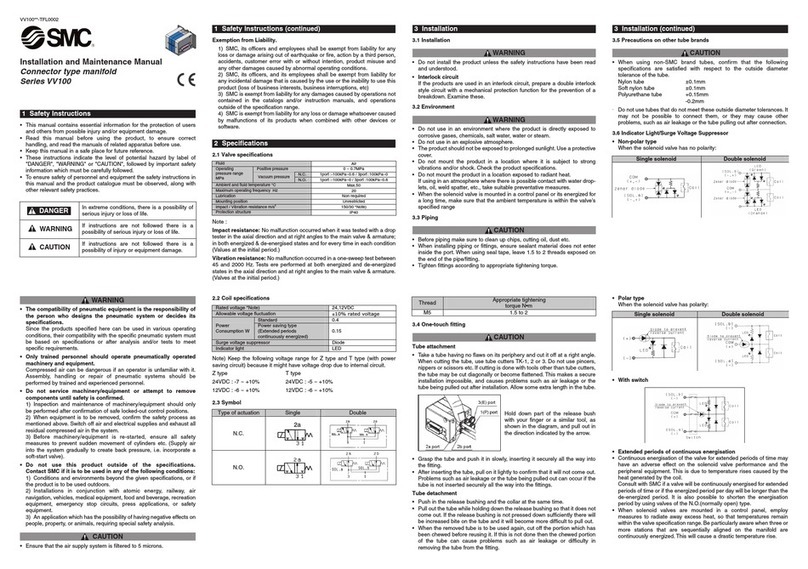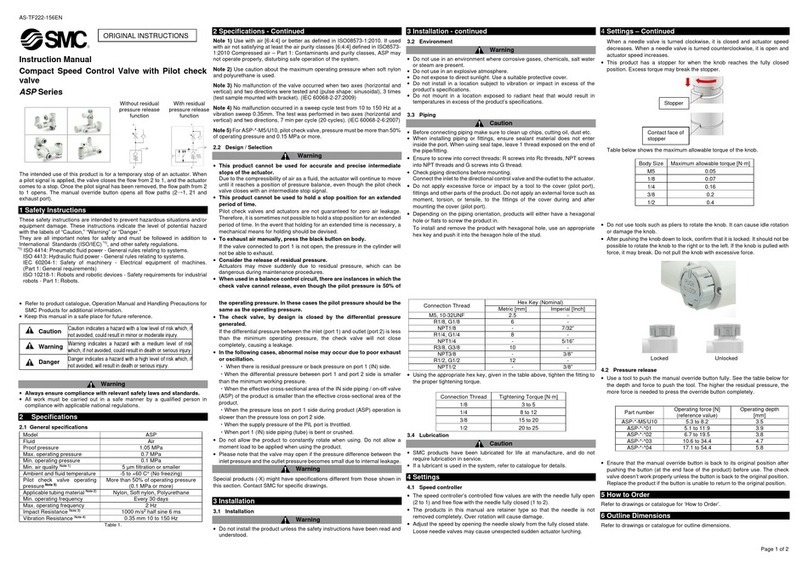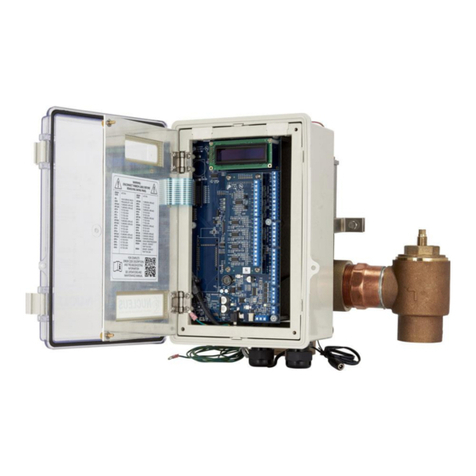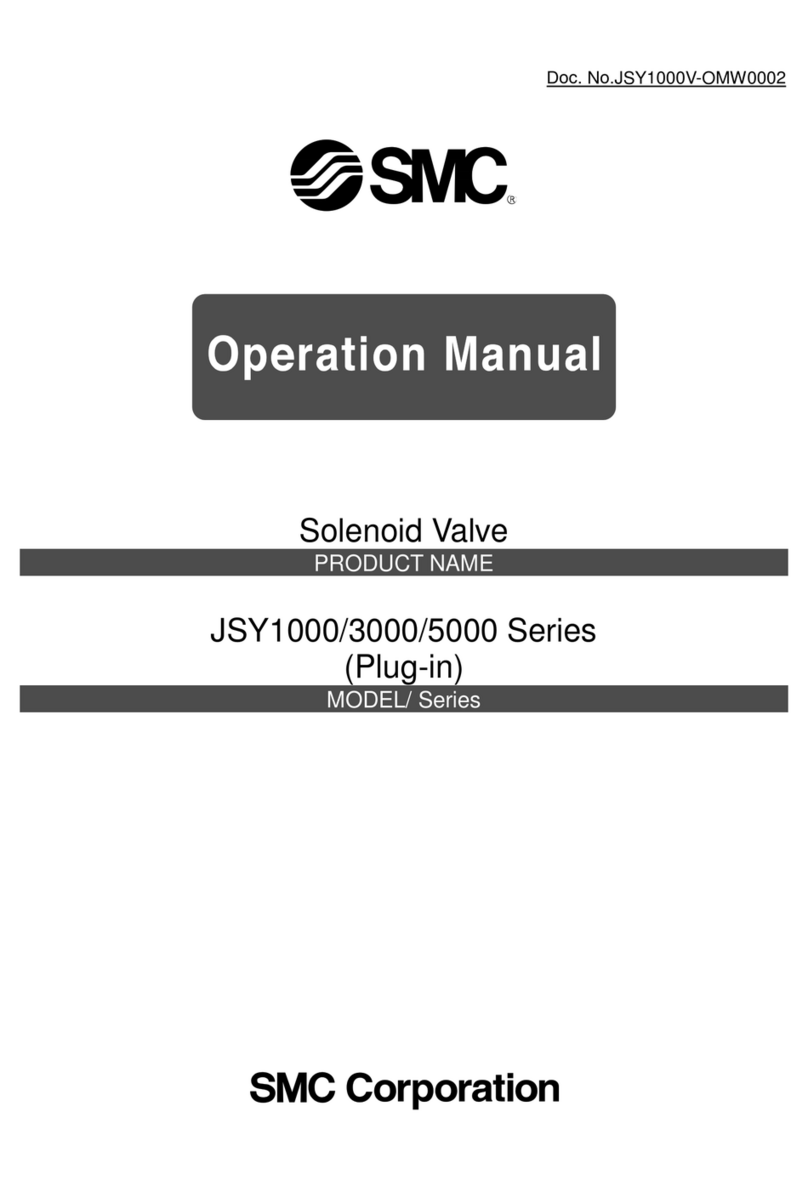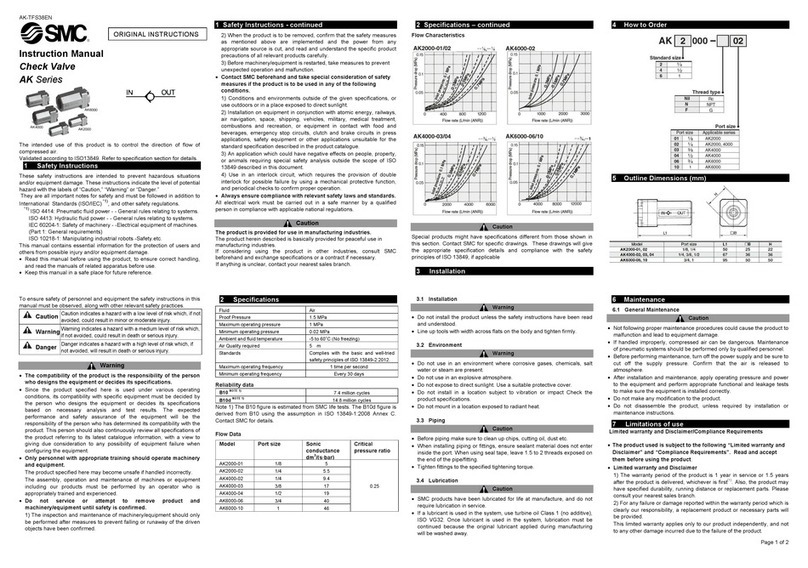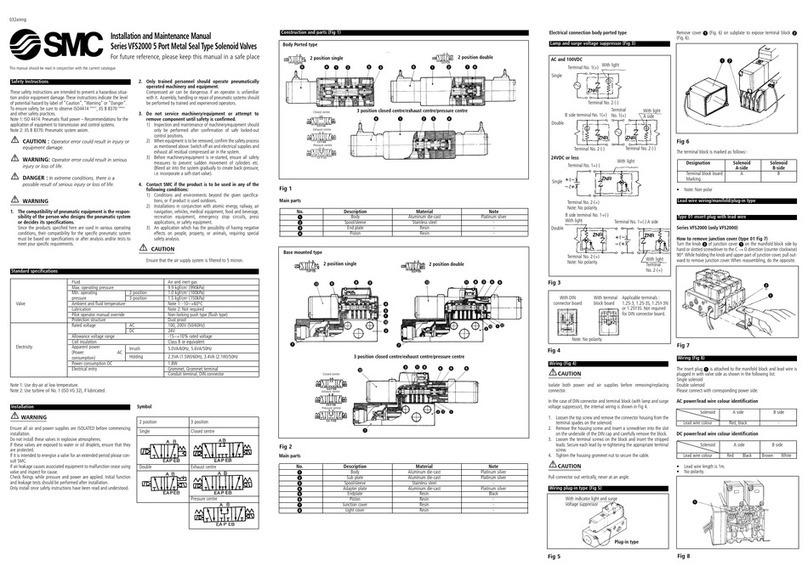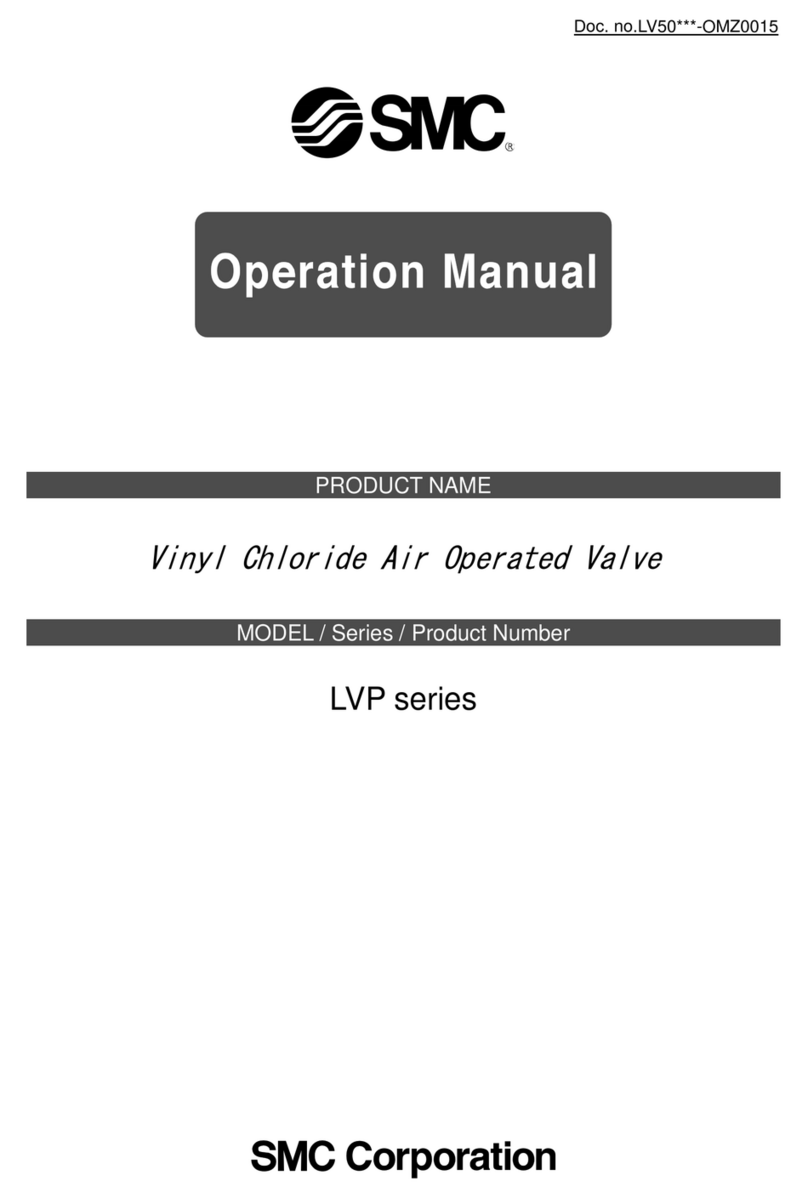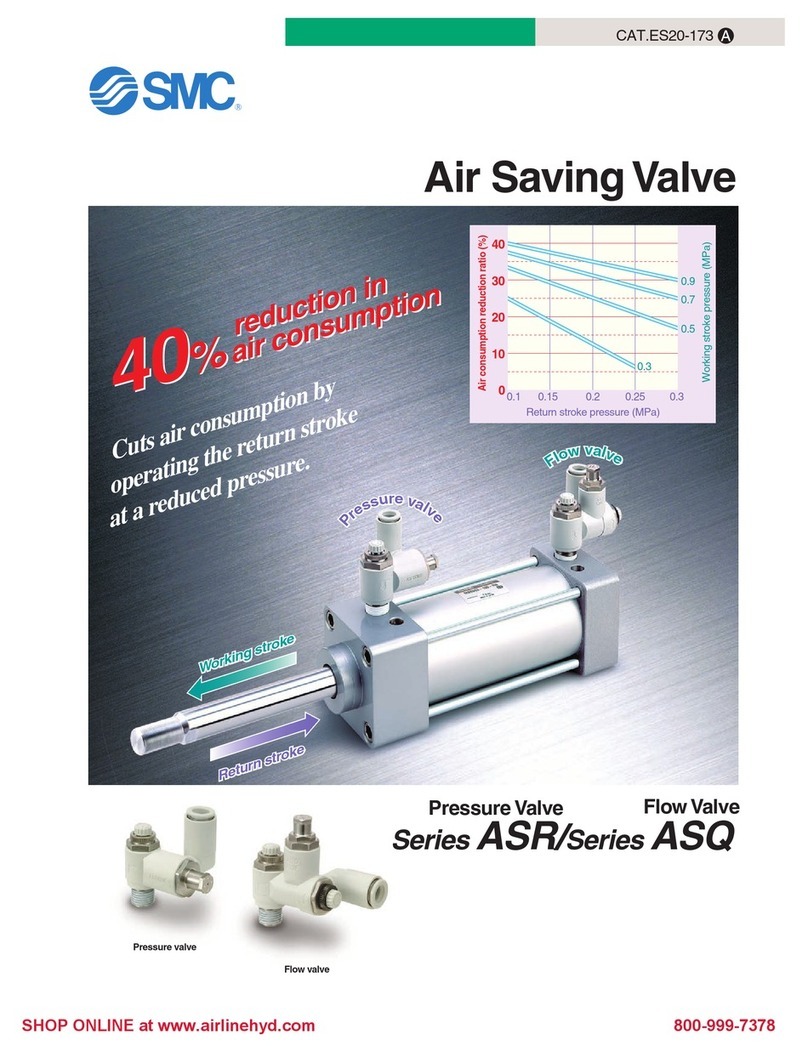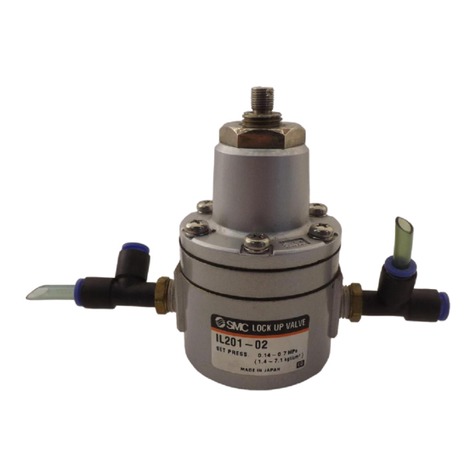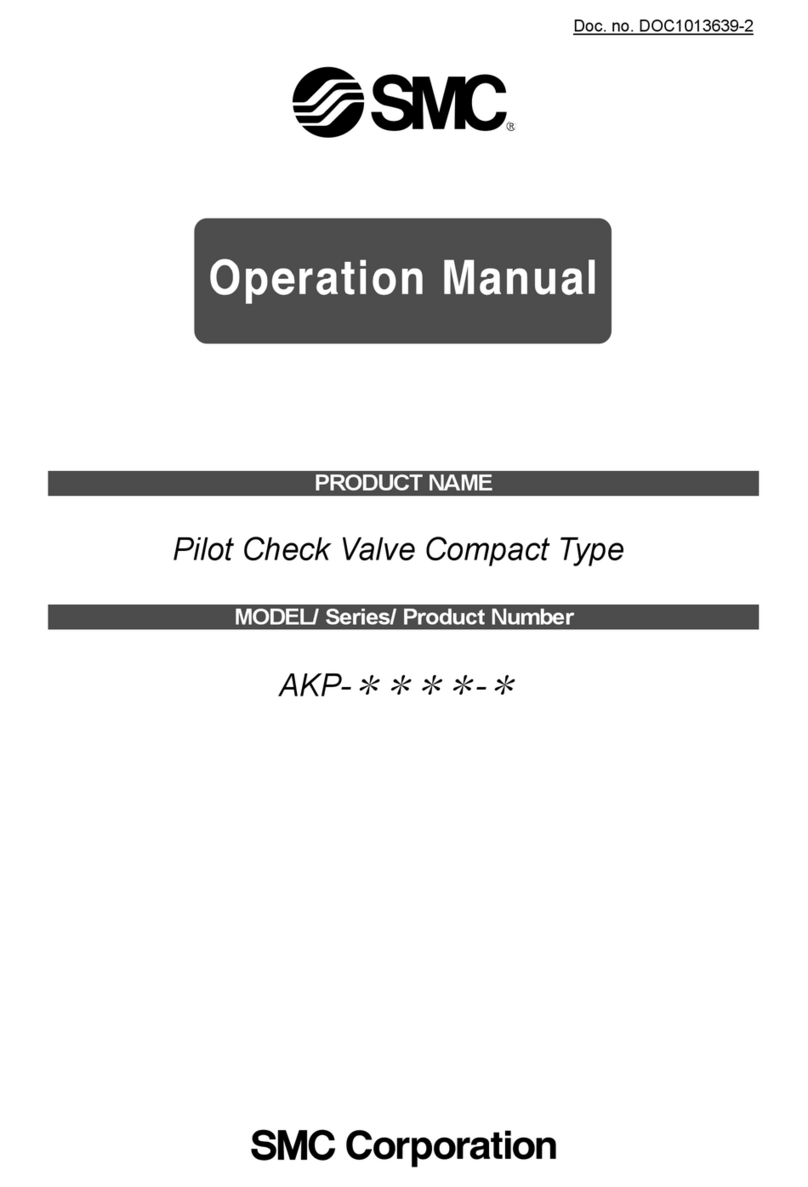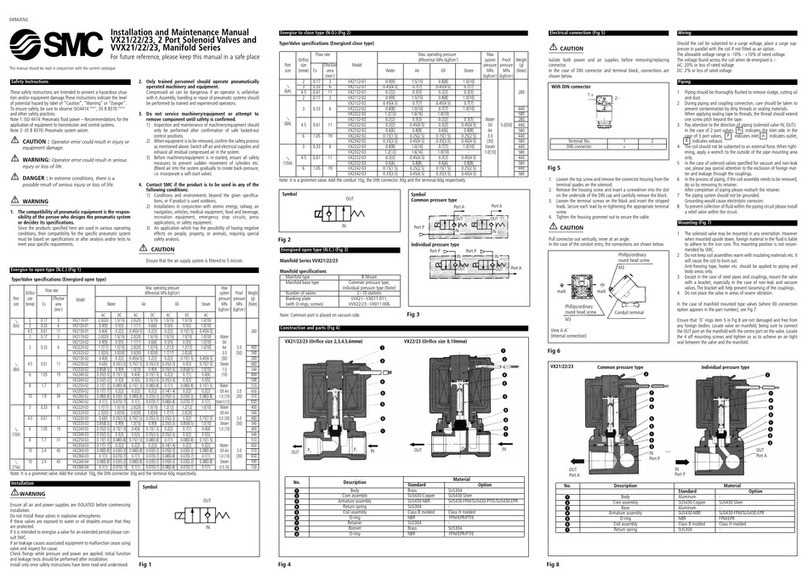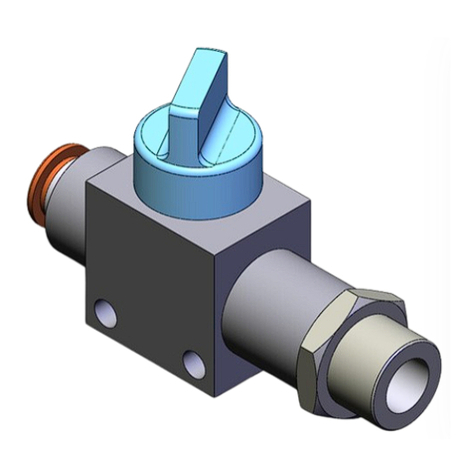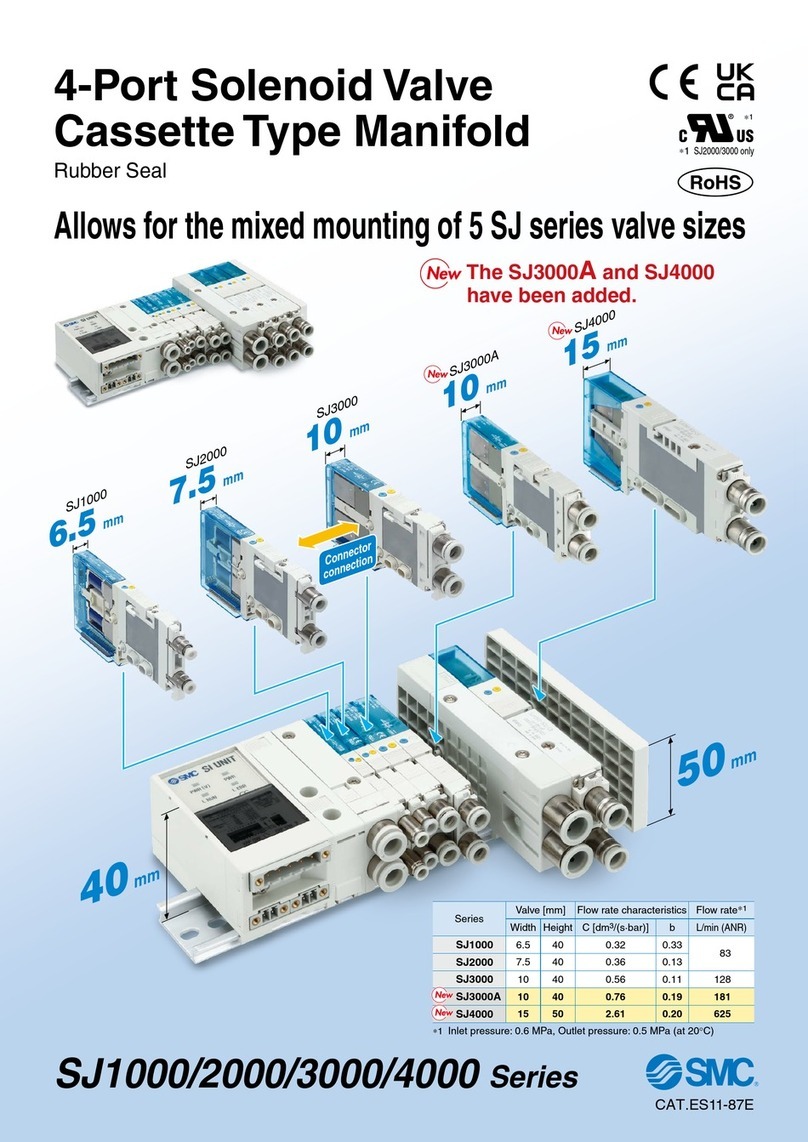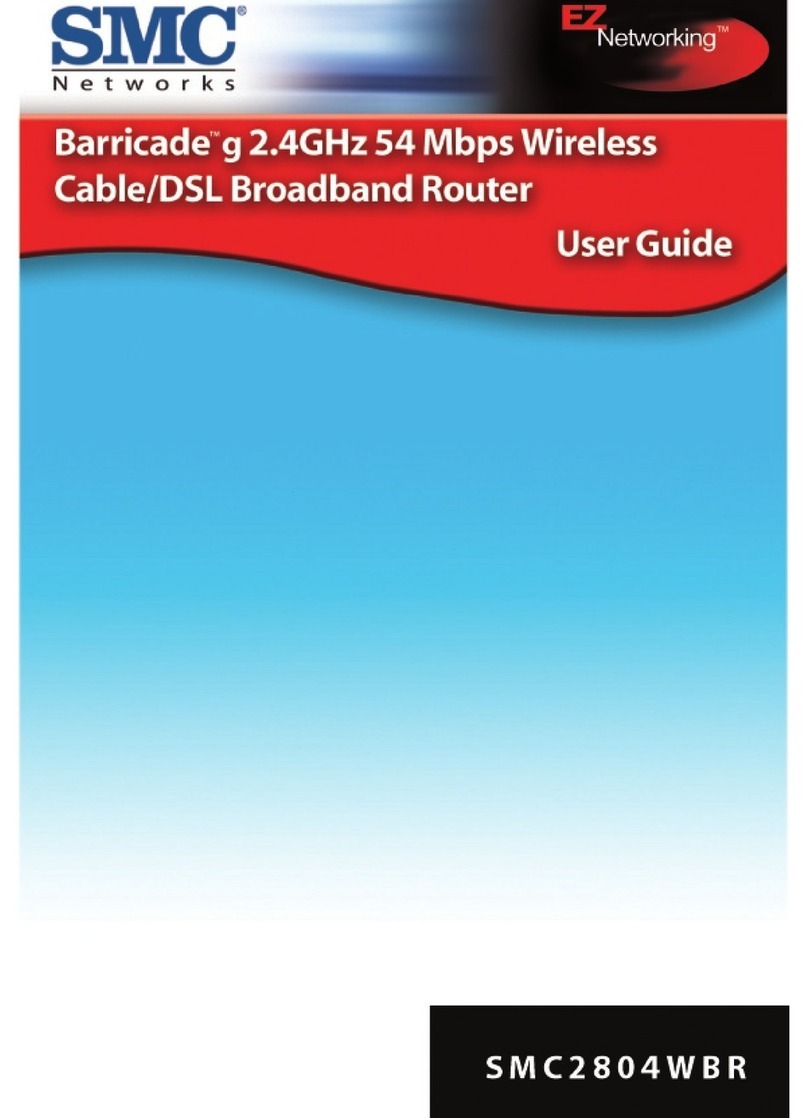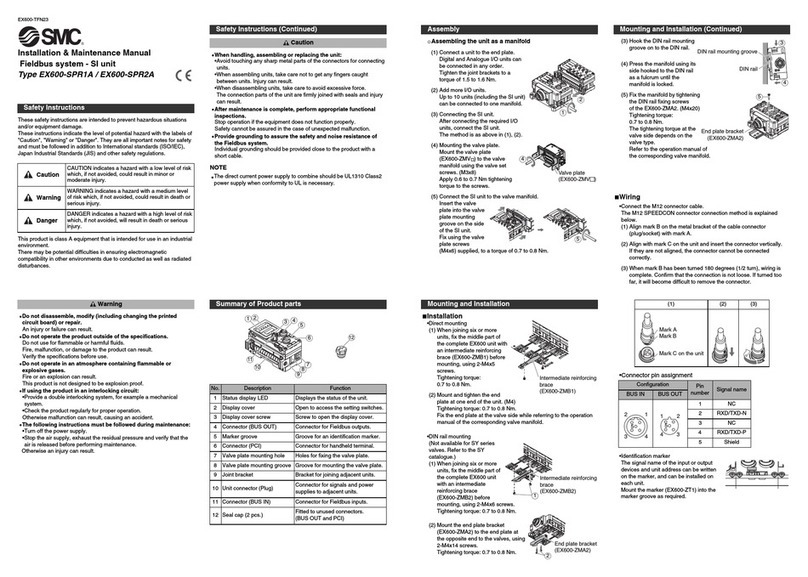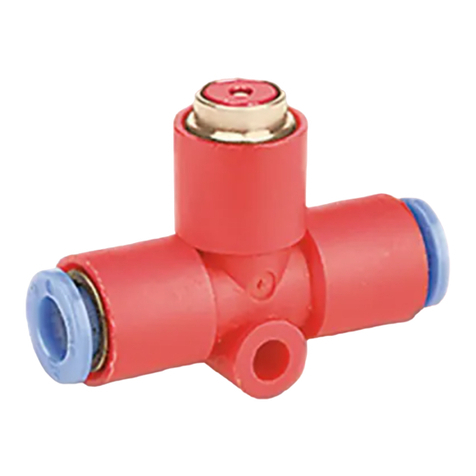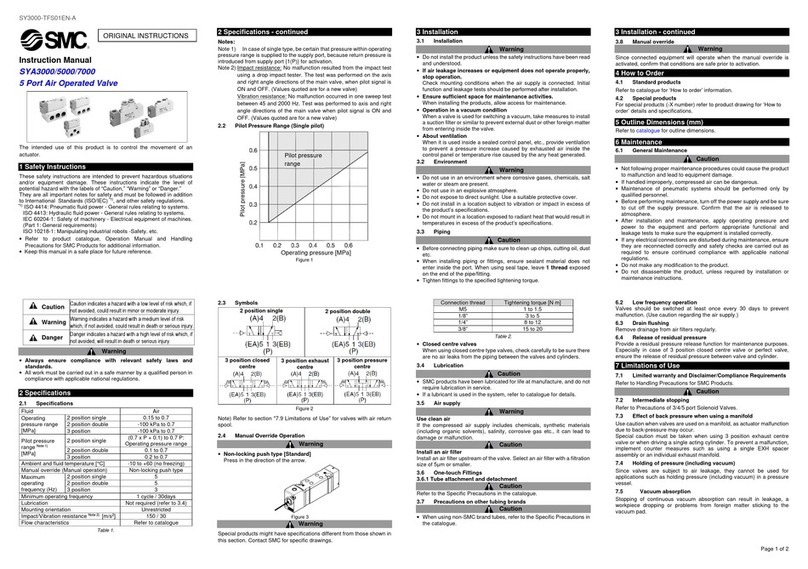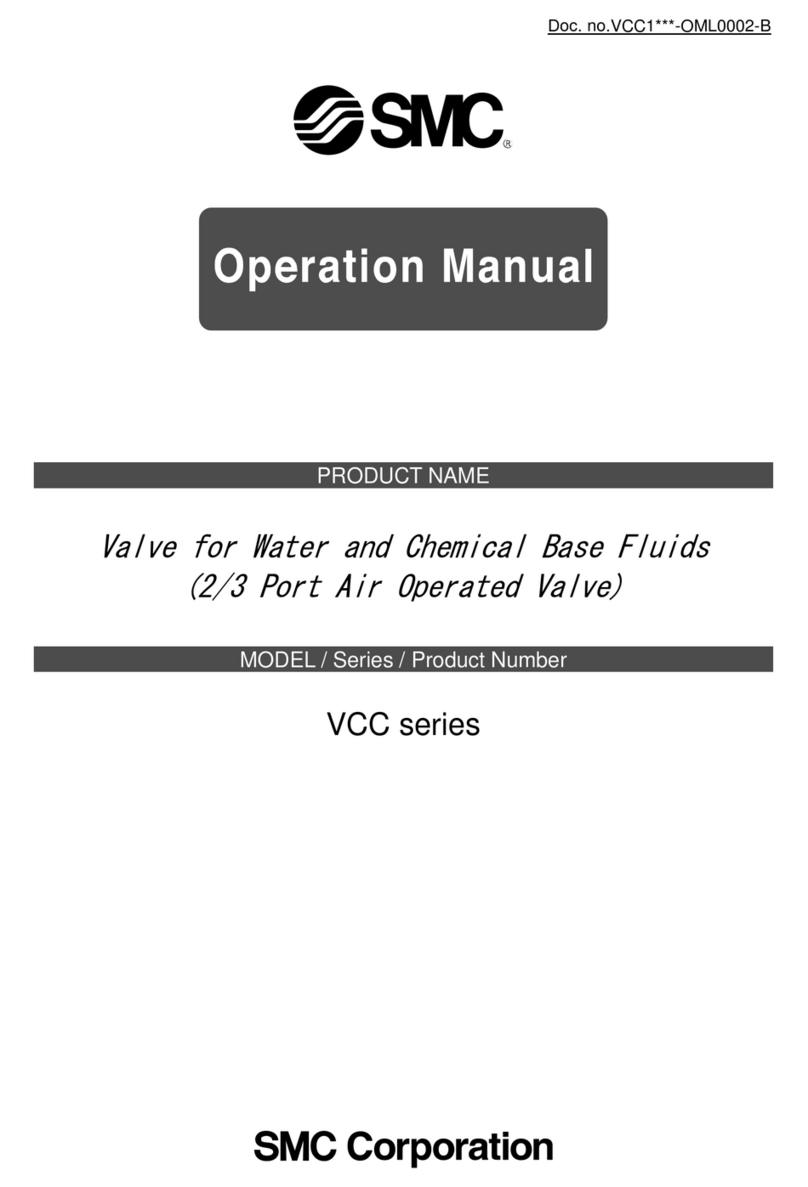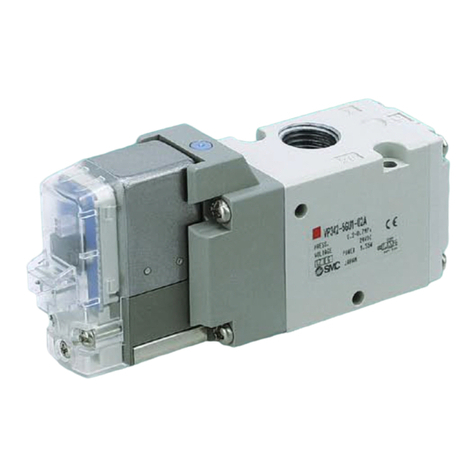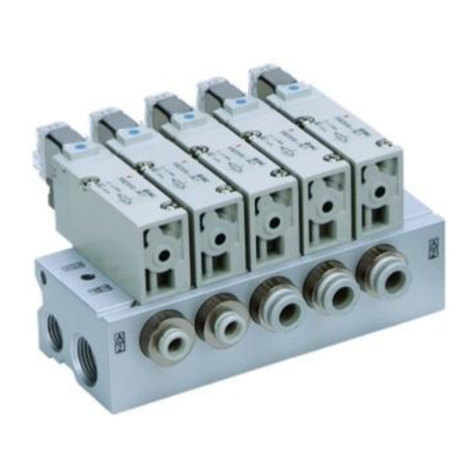VXSS-TFR48
6 Maintenance (continued)
6.3 Low frequency operation:
•Switch valves at least once every 30 days to prevent malfunction. Also,
in order to use it under the optimum state, conduct a regular inspection
once every 6 months.
Caution
6.4 Filters and strainers:
•Be careful regarding clogging of filters and strainers.
•Replace filter elements after one year of use, or earlier if the pressure
drop reaches 0.1 MPa.
•Clean strainers when the pressure drop reaches 0.1MPa.
6.5 Lubrication:
•When using after lubricating, never forget to lubricate continuously.
6.6 Storage:
•In case of long term storage after use with heated water, thoroughly
remove all moisture to prevent rust and deterioration of rubber materials,
etc.
7 Limitations of Use
Warning
•Do not exceed any of the specifications laid out in section 2 of this
document or the specific product catalogue.
7.1 Confirm the specifications:
•Give careful consideration to the operating conditions such as the
application, fluid and environment and use within the operating ranges
specified.
7.2 Fluid:
•Type of fluid;
Before using a fluid, confirm whether it is compatible with the materials
for each model by referring to the fluids listed in the catalogue.
•Corrosive gas;
Cannot be used since it will cause cracks by stress corrosion or result in
other incidents.
•When a brass body is used, then depending on water quality, corrosion
and internal leakage may occur. If such abnormalities occur, exchange
the product for stainless steel body.
•Use an oil-free specification when any oily particles must not enter the
system.
•Applicable fluid in the catalogue list may not be suitable depending on
the operating conditions. Give adequate consideration and then
determine a suitable model, as the compatibility list is for general case.
7.3 Fluid quality: Steam, Water
•The use of a fluid that contains foreign matter can cause problems such
as malfunction and seal failure by promoting wear of the valve seat and
armature, and by sticking to the sliding parts of the armature, etc.
•Install a suitable filter (strainer) immediately upstream from the valve. As
a general rule, use 80 to 100 mesh.
•However, the size and shape of foreign objects that occur depends on
the operating environment. Check the fluid state and choose an
appropriate mesh size.
•The supply water to a boiler includes materials that create a hard
sediment or sludge such as calcium and magnesium. Sediment and
sludge from steam can cause the valve not to operate properly. Install a
water softening device which removes these materials.
•Do not use steam which contains chemicals, synthetic oils containing
organic solvents, salts or corrosive gases etc., as these can cause
damage or deterioration.
•As the special FKM used in this product has higher alkali resistance than
general FKM, it can be used with steam containing boiler compounds.
However, the resistance to other chemicals such as organic solvents is
the same as general FKM. Please confirm resistance to the components
of the boiler compound before use.
7 Limitations of Use (continued)
7.4 Leakage voltage:
When connecting C-R element parallel to switching element, leakage
current flows through C-R element and the leakage voltage increases.
Figure 10
Ensure that the voltage leakage across the coil is as follows:
AC coil: 5% or less of rated voltage.
DC coil: 2% or less of rated voltage.
7.5 Low temperature operation:
•The valve can be used in an ambient temperature of between -10 to
-20°C. However, take measures to prevent the water from freezing or
solidification of impurities, etc.
•When using valves for water application in cold environments, take
appropriate countermeasures to prevent water freezing in the system,
after the water supply from the pump is cut off, by draining the water,
etc.
•When warming by a heater, etc, be careful not to expose the coil
assembly to the heater.
•For air, installation of a drier and heat retaining of the body is
recommended to prevent a freezing condition in which the dew point
temperature is higher than the ambient temperature.
7.6 Cannot be used as an emergency shut-off valve etc.
•This product is not designed for safety applications such as an
emergency shut-off valve. If the valves are used in this type of system,
other reliable safety assurance measures should also be adopted.
7.7 Extended periods of continuous energization
•The solenoid coil will generate heat when continuously energized, so
avoid installing in an enclosed space. Install in a well-ventilated area.
•Do not touch the coil while it is being energized or immediately after
energization.
•Be especially careful when using three or more adjacent valves with
manifolds and keeping them continuously energized for extended
periods, as this may result in dramatic increases in temperature.
7.8 Liquid circuits
•In cases with flowing liquid, provide a bypass valve in the system to
prevent the formation of a sealed circuit.
7.9 Steam hammer
•When problems are caused by steam hammer, install steam hammer
relief equipment (accumulator, etc.).
7.10 Back pressure
•If there is a possibility of back pressure being applied to the valve, take
countermeasures such as mounting a check valve on the downstream
side of the valve.
7.11 Pressure holding
•Not suitable for an application such as holding pressure inside a
pressure vessel, because the valve has some leakage.
7.12 Usage with low flow
•Unstable flow may occur under the following conditions;
Low flow from the pump or boiler, etc.
Use of several elbows or tees in the circuit.
Thin nozzles installed at the end of piping, etc.
7 Limitations of Use (continued)
These can cause valve opening/closing failure or oscillation and cause a
valve malfunction.
•Check the pressure differential and flow to select the appropriate size of
valve by referring to the flow rate characteristics. Ensure the pressure
differential does not become less than 0.01MPa during ON (N.C.: Valve
Open).
7.13 Rapid pressure changes
•If used in conditions in which rapid decrease in the inlet pressure and
rapid increase in the outlet pressure of the valve are repeated, excessive
stress will be applied to the piston, which causes damage to the piston,
leading to malfunction of the valve.
Check the operating conditions before use.
7.14 Sudden inlet pressure increase
•When valve is closed and pressure is applied suddenly due to starting of
fluid supply source, such as boiler, the valve may open momentarily and
fluid may leak.
8 Contacts
